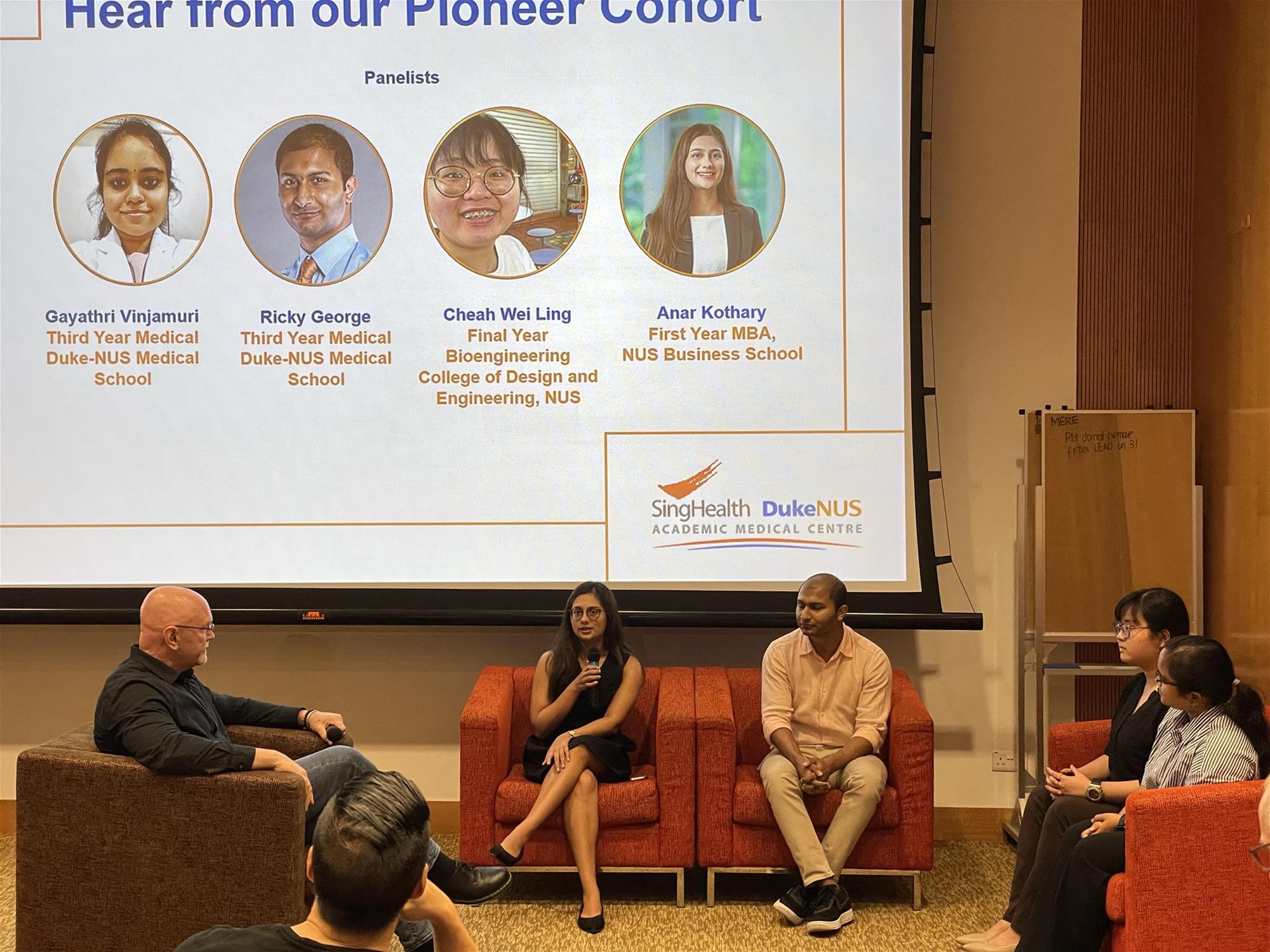
 Leveraging the pandemic, this surgeon-innovator proves that even in healthcare, new ideas can be turned into innovations fast.
Leveraging the pandemic, this surgeon-innovator proves that even in healthcare, new ideas can be turned into innovations fast.
“Why should nasopharyngeal swabs be only done by doctors or specialists?” asks Dr Rena Dharmawan. For Dharmawan, a then-associate consultant with the Department of Head and Neck Surgery in the Division of Surgery and Surgical Oncology at Singapore General Hospital and the National Cancer Centre Singapore, this question was not rhetorical.
By late April, specialists like Dharmawan had been deployed in droves first to emergency rooms, later to dorms across Singapore. Their task? To conduct nose swabs for intensive SARS-CoV-2 testing, while ensuring that the tests were performed accurately and without injury to patients.
They worked long shifts in full-body hazmat suits and N95 masks to protect against infection.
They risked not just their personal safety but that of their families. “It was worrying,” says Dharmawan, who admits that the uncertainty of the pandemic made her feel very uncomfortable. “I have two young kids, and I really didn’t want to expose them to the virus.”
In times of crisis, the speed of innovation can make or break a nation’s response. The pressure was building as Singapore experienced its first large-scale outbreak. Each clinician saw up to 130 patients per shift, starting at 9am, ending at 5pm. Dharmawan recalls that almost all were COVID-positive.
As infections spread, the need for testing — not just those at risk of having the virus in the community but travellers too — skyrocketed. And Dharmawan, a serial innovator and a then-assistant professor of clinical innovation with Duke-NUS Office of Innovation and Entrepreneurship, was clear about one thing: if she could harness the power of automation, she would be able to develop a better, more efficient and cheaper way of doing this.
“Couldn’t swab tests be as simple as getting a check at an optometrist? Step into a booth, put your head here, get your nose swabbed, and get your results. That was the grand idea,” Dharmawan remembers thinking.
And she had never been one to stop at thinking.
Clinicians and engineers, assemble
Dharmawan wears multiple hats at work. She is a cancer surgeon as well as an enthusiastic innovator with a background in bioengineering. She was an entrepreneur-in-residence with the Centre for Technology and Development at Duke-NUS and is an alumnus of the School’s very first cohort of graduates, the Class of 2011.
And she already had plenty of experience under her belt.
“I became ‘addicted’ to innovation early on,” says Dharmawan, who had already co-founded several Singapore-based startups while completing her residency training including home-based haemorrhoids management solution Privi Medical as well as on-demand healthcare platform Jaga-Me.
At the suggestion of her innovator-mentor, Dharmawan and a group of SingHealth clinicians banded together in April 2020 with medical robotics company Biobot Surgical. The company had previously developed a surgical robot with a probe that was similar to what Dharmawan had in mind.
It took them a mere three weeks to develop a prototype. “Of course, it was more of a metal skeleton then,” remarks Dharmawan, “but it worked.”
A four-month miracle
The team’s target development timeline was ambitious. “What I wanted to prove was that amidst COVID, we could build a commercially viable solution in just a few months,” says Dharmawan.
The biggest roadblock Dharmawan had to navigate was the requirement back then for wet ink signatures on agreements and contracts.
“These are COVID times, and electronic signatures exist; so why did we need to bring documents to people’s houses to get signatures in-person?” she recalls, shrugging. She was once again operating ahead of the status quo, which would soon see electronic signing implemented across the School.
No matter. After a few trans-island journeys, Dharmawan and her team secured the documents required. By July 2020, the world’s first patient-controlled nasopharyngeal swab robot — SwabBot — was ready for clinical trials.
Dharmawan still remembers the reaction of a senior urologist when she presented her innovation at a SingHealth COVID-19 taskforce meeting. His first comment, Dharmawan recalls, was: “‘You know that your team basically did what we took ten years to do, right?’”. He was referring to the iSR’obot Mona Lisa prostate biopsy robot, which had also been developed in collaboration with Biobot and that contained the same mechanism central to Dharmawan’s prototype.
“SwabBot is much simpler, and obviously Biobot’s experience counts,” acknowledges Dharmawan, “But it’s still a miracle that we pushed this through in four months.”
Quality swabs in seconds
White, sleek and about the size of a large house cat, the SwabBot prototype looked friendly and was easy to use.
Users would take a seat, rest their hands on its handles, place their nose against the disposable nose piece, and gently press their chin against a conveniently located button. And in just 20 seconds, the swab was done. Throughout the process, the user was in full control, and able to start and end the swab at will. And thanks to that feature which makes use of a quirk in human psychology, SwabBot users reported less discomfort.
“Just like how you can’t tickle yourself, you experience less pain when you are fully in control compared to having someone twirl a swab in your nose,” Dharmawan explains.
While swabbing pressure varies with human swabbers, SwabBot’s touch sensor was calibrated to the delicate sensitivity of a surgeon performing microvascular surgery. “It retracts on encountering resistance, and if it is not a good quality swab, it tells you to please do it again until you pass,” says Dharmawan.
All this meant that SwabBot yielded swabs of consistently high quality. This while offering to decrease the swabber’s exposure risk and reduce the need for trained manpower.
Contributing to the wider clinician-innovator ecosystem
When it comes to new technologies and innovations, healthcare has traditionally been among the last industries to adopt them. But the pandemic shook this state of affairs, accelerating digital health innovation as virtual consultations and digital platforms became commonplace.
And credit for Singapore’s growing biotech and medtech innovation space goes to institutions such as Duke-NUS and SingHealth, says Dharmawan. “They are making it a lot easier for anyone with a promising idea to navigate the research ecosystem.”
With SwabBot in the hands of Biobot, Dharmawan embarked on the next project: a programme for Duke-NUS medical students to discover the innovation bug, just as she had. Offered to Duke-NUS medical students, who spend their third year immersed in research, Dharmawan planned to bring them together with peers from other NUS schools, clinicians and industry partners to conceptualise, develop and prototype an innovation.
“By bringing products to market, be it through startups, licensing, or multinational company spinoffs, we can create a multiplier effect that impacts the lives of our patients,” she says, hoping that like her, these students will grow into similarly passionate innovators. Called the Health Innovator Programme, it would go on to be officially launched on 23 September 2022.

STUDENTS FROM THE INAUGURAL COHORT OF THE DUKE-NUS HEALTH INNOVATOR PROGRAMME TALK ABOUT WHAT MOTIVATED THEM TO APPLY AT THE LAUNCH OF THE PROGRAMME
While she started with medical students, she hopes to engage residents — clinicians who are pursuing their specialist training — in the future, too.
“They are young and savvy. If they see the light when their idea is licensed or spun-off, I think they could get hooked and carry on even as they become consultants,” explains Dharmawan, who was in the midst of pursuing an Executive MBA, a qualification she hoped will further boost her projects.
Eventually, she hopes to develop a sustainable funding pipeline not just from public grants but also private funding. Her moon-shot goal? To build an independent laboratory that drives innovations, works closely with industry and engineering stakeholders and delivers a training programme that feeds into a sustainable ecosystem of clinician-innovators.
“To me, that would be the dream.”